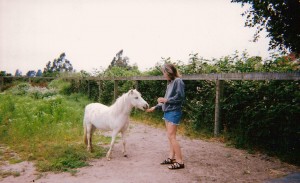Today I had to begin the springtime confinement of Pegasus. I left the donkeys in with her for this first day of not being free to roam and they are calling to me right now, asking to be let out. I love the spring with all the flowers and the birdsongs, but my heart shrinks as the Ides of March approach.
For with the Ides of March, Pegasus has to be kept in the smaller paddock area from then until the grasses dry out, usually early June. This year she got a few extra days of freedom because of the late rains. The juice hasn’t coursed into the grass yet. If I couldn’t tell by looking at the still-short grass, I could tell because the sheep haven’t gained weight. When the grass gets rich, they plump out almost overnight.
Pegasus cannot graze the rich spring grass because she has a tendency to founder and the grass can easily send her into an episode. Every year, I watched her carefully for the telltale sign of a beginning of stiffness in her front legs. Then I pulled her off the grass. That was the way I did it until an old-school vet, full of the wisdom of a lifetime of treating animals, said horses like Pegasus have to be pulled off the grass by the Ides of March. So now it’s clearer. Pegasus knows the yearly routine, and keeping her in is a small price to pay for avoiding that painful, dreadful condition.
Along with the Ides of March tip, I’ve learned other secrets for preventing founder/laminitis and treating Cushing’s syndrome, a condition that leaves a horse vulnerable to founder/laminitis. For horses who have this problem, here’s a good protocol:
- Pull the horse off the spring grass (in northern California, by the Ides of March).
- All year round, feed low-carbohydrate orchard grass hay. High-carb hay has made Cushing’s a near epidemic among horses and donkeys (like human diabetes from a high-carb diet).
- Have a farrier experienced in trimming horses who have foundered trim the horse’s hooves regularly (every 8 weeks, or more often as needed—sometimes the toes grow fast with founder).
- If you give feed pellets, use something like LMF Stage 1 pellets, which are low-carb. Do not give high-carb pellets.
- For horses with Cushing’s, the herb vitex (Vitex agnus-castus), also called chaste berry, can be very helpful. I credit this as saving Pegasus from having to be on the drug for Cushing’s. Vitex helps balance out hormonal problems in human women. Since the pituitary gland, which regulates the hormonal system, is implicated in Cushing’s, this is why Vitex helps. I give Pegasus (who weighs about 450 pounds) a heaping teaspoon a day, mixed in wet pellets—3 weeks on, 1 week off (it’s important not to overdo the hormonal input). A full-size horse (about 1000 pounds) would need a larger daily dose. Check online for the recommended dosage.
- For horses with Cushing’s or those prone to founder/laminitis, give the following herbal formula daily. The animal bodyworker Cindy Schleuss gave me this formula and it helped save Pegasus from her chronic state:
1 part kelp powder
1 part ground licorice
3 parts burdock root
3 parts milk thistle
I buy the first two from the health food store already in powder form. I grind the last two in an herb/coffee grinder. Get organic because founder is now thought to be a condition of toxicity (thus the milk thistle, which supports the liver). Mix all together. For a full-size horse , give two level tablespoons daily. Pegasus is about 450 pounds and she gets one level tablespoon. I mix this and the vitex with the wet LMF pellets. The pellets soak up a lot of water so make sure the mash isn’t too dry. Cindy judges the need for his formula according to the horse’s coat. When the coat becomes shiny and sleek instead of patchy and shaggy (like Cushing horses’ coats often are), she stops giving it, and resumes it as needed. I give it to Pegasus on the three weeks on, one week off schedule of the vitex and have been for a few years now. The combination is keeping her Cushing’s under control. Thank you, Cindy!

